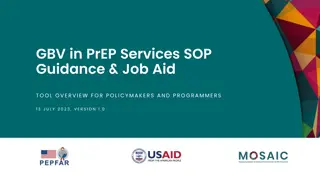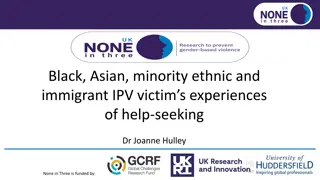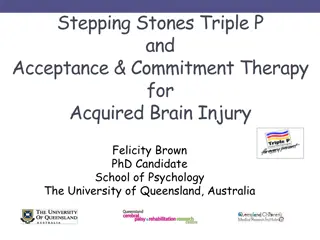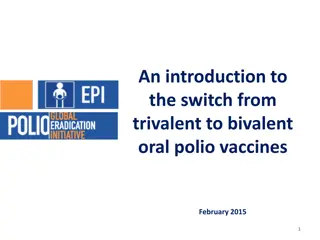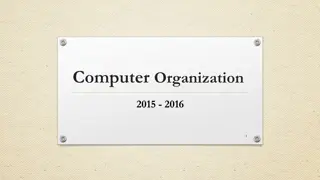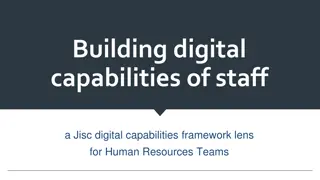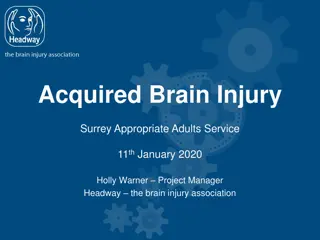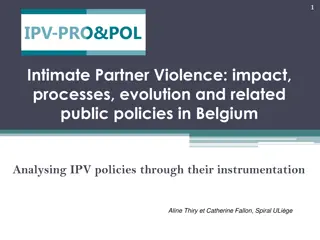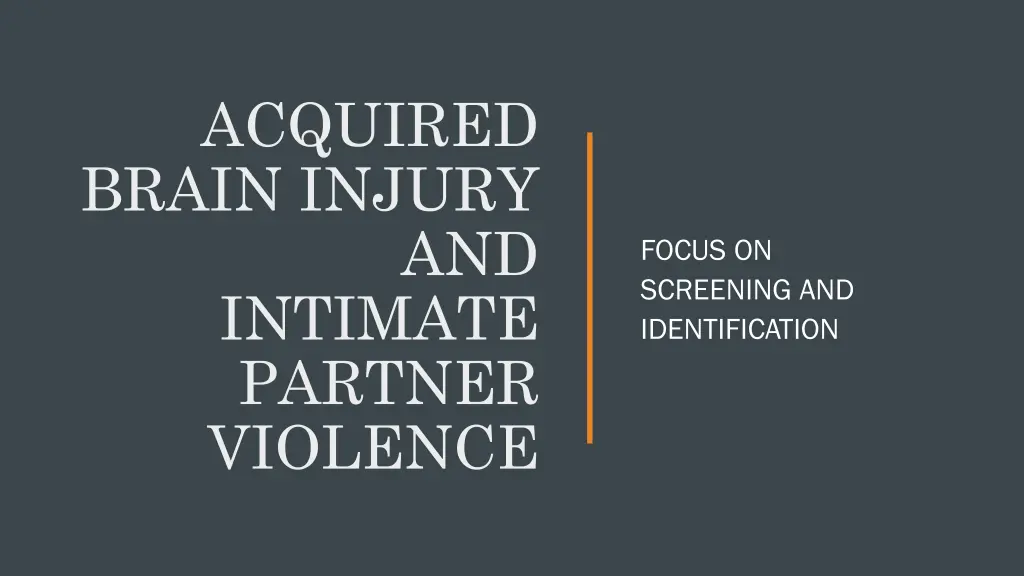
Identifying IPV-Related ABI Prevalence
Learn about the prevalence of acquired brain injury (ABI) in victims of Intimate Partner Violence (IPV) and the importance of screening and identification. Understand the impact of ABI and IPV, screening tools available, recommended actions for detection, and services for IPV victims with ABI. Discover the public health emergency IPV poses and the underreported prevalence of ABI in IPV cases.
Download Presentation

Please find below an Image/Link to download the presentation.
The content on the website is provided AS IS for your information and personal use only. It may not be sold, licensed, or shared on other websites without obtaining consent from the author. If you encounter any issues during the download, it is possible that the publisher has removed the file from their server.
You are allowed to download the files provided on this website for personal or commercial use, subject to the condition that they are used lawfully. All files are the property of their respective owners.
The content on the website is provided AS IS for your information and personal use only. It may not be sold, licensed, or shared on other websites without obtaining consent from the author.
E N D
Presentation Transcript
FOCUS ON SCREENING AND IDENTIFICATION
Prevalence of concurrent metal illness and substance use in victims of IPV with ABI Prevalence of Acquired Brain Injury (ABI) and Intimate Partner Violence (IPV) Need for screening for ABI in IPV LEARNING OBJECTIVES: Recommended actions to improve detection of ABI in victims of IPV Screening tools, e.g., HELPS Screening cautions Services available for victims of IPV with ABI Benefits of screening
IPVA PUBLIC HEALTH EMERGENCY A recent Canadian study estimates that 44% of women and 36% of men will experience IPV during their life and more than half of these will experience physical violence (Cotter, 2021)
ACQUIRED BRAIN INJURY AND INTIMATE PARTNER VIOLENCE: Intimate Partner Acquired Brain Injury (ABI) is brain injury which is not associated with human development. It includes Traumatic Brain Injury (TBI) associated with a blow to the head from accidents or assaults and brain injury resulting from disease, such as stroke, tumors or ischemic deprivation, i.e. hypoxia and anoxia. Violence (IPV) is unfortunately common in our society and involves psychological and physical violence with women being the most frequent victims. The physical violence usually involves blows to the head which may result in TBI and/or strangulation, causing hypoxic or anoxic brain injury.
PREVALENCE OF ABI AND IPV: There are very variable estimates of prevalence of ABI associated with IPV , ranging from 20-90% The prevalence is probably higher in indigenous populations (Haag et al, 2019) One widely cited reference on prevalence is Eve Valera who wrote: "In a sample of women who had sustained partner abuse, 75% suffered at least one abuse-related TBI (including anoxic and hypoxic incidents from strangulation) and nearly 50% sustained repetitive TBIs, sometimes as many as too many to count. (Valera, 2018, p.735)
PREVALENCE OF ABI AND IPV: Clearly there is a need for screening to identify individuals requiring services as well as to acquire better data for planning and evaluating services The prevalence estimates are underreported by women because of shame and fear of retaliation by perpetrators There is little or no screening for ABI in IPV cases
AT THE INTERSECTION OF IPV, ABI, MENTAL ILLNESS AND SUBSTANCE USE: A review of the prevalence of mental illness among individuals who experienced IPV and BI showed rates of depression raging from depression ranging from 25 to 86%, anxiety ranging from 32 to 100% and PTSD ranging from 29 to 100%. Additionally, two studies reported the prevalence of substance use ranging from 28 to 33%. (Toccalino et al, 2023)
PREVENTION OF ABI FROM IPS: In Public Health, there are two types of prevention, Primary and Secondary. Primary prevention of IPS aims to prevent intimate partner Violence from occurring; Secondary prevention is preventing further assaults of the victim by the perpetrator. Unfortunately , the opportunities for Primary Prevention are limited we need to focus on Secondary Secondary Prevention Prevention, detecting IPV via screening and mitigating the harm.
ACTIONS TO IMPROVE THE DETECTION OF ABI IN IPV CASES: Implement effective ABI screening for individuals identified as IPV survivors Improve health and social service information systems Improved Professional Development and education re ABI and IPV is essential; this should begin in the college and university programs, e.g., nursing and medicine
IMPROVING THE SCREENING OF ABI IN IPV CASES: Who? ER staff doctors, nurses and social workers; Social service and shelter staff Where? ER's, Psychiatric units, Womens' shelters When? At intake, ideally How? Routine screening with appropriate tools
SCREENING TOOLS There are several ABI screening tools available. For a review of those considered most appropriate for detecting IPV associated ABI see Goldin et al (2016) HELPS was originally developed by Picard et al (1991) and has since been modified to include questions about suffocation. The advantages of this instrument are that it can be quickly and easily administered by staff without TBI expertise and with minimal training
SCREENING INSTRUMENTS: A CAUTIONARY NOTE It is essential that screening only occurs with the full, informed consent of the participant. Any information must be kept confidential and particularly kept from perpetrators who may use this knowledge to further abuse, control or discredit a survivor, possibly in legal and/or child custody disputes. All staff working in situations where screening occurs require training in confidentiality and related risk management Processes must be in place to assure that information only goes to appropriate individuals and organizations such as service providers and only with the individual's consent Anonymized and aggregated information should be collected and reported to health authorities and ministries to plan and provide appropriate services
ADVANTAGES OF SCREENING: Most importantly, screening will help identify individuals who require services, i.e. community brain injury services, rehab, community mental health services including psychosocial rehabilitation and substance use services Improved access to supports including housing, education and employment Increased and improved understanding, planning and provision of services by health, mental health and social service organizations, police and the legal system
WHAT SERVICES ARE AVAILABLE ?
REFERENCES Goldin Y, Haag HL, Trott CT. (2016) Screening for history of traumatic brain injury among women exposed to intimate partner violence. PM&R. 8:1104 10. 10.1016/j.pmrj.2016.05.006 Haag, H., Biscardi, M., Smith, N., MacGregor, N., & Colantonio, A. (2019). Traumatic brain injury and intimate partner violence: Addressing knowledge and service gaps among indigenous populations in Canada. Brain Impairment, 20(2), 197-210. doi:10.1017/BrImp.2019.16 Picard, M., Scarisbrick, D., and Paluck, R. (1991). HELPS: A brief screening device for traumatic brain injury. Comprehensive Regional TBI Rehabilitation Center. Toccalino D, Moore A, Cripps E, Gutierrez SC, Colantonio A, Wickens CM, Chan V, Nalder E, Haag HL. (2023) Exploring the intersection of brain injury and mental health in survivors of intimate partner violence: A scoping review. Front Public Health, Mar 2;11:1100549. doi: 10.3389/fpubh.2023.1100549. PMID: 36935693; PMCID: PMC10018197.

